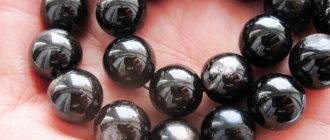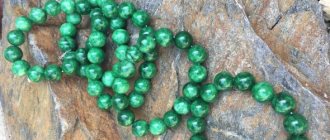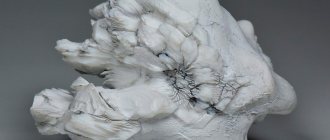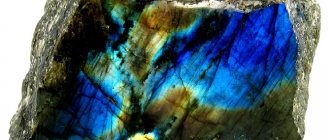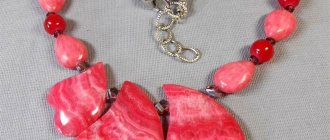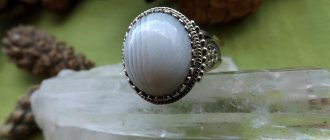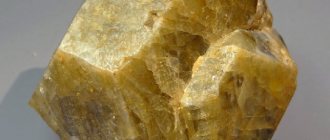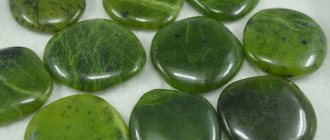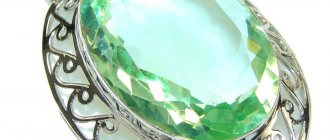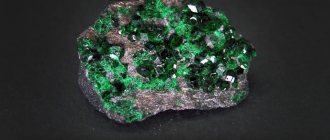Excursion into history
Translated from ancient Greek, “pir” means “fire.” The mineral was named so for its external resemblance and the belief that with its help you can quickly and easily get fire. Indeed, a couple of blows are enough for sparks to appear, which is what all peoples did from ancient times to the era of flintlocks.
The Incas made mirrors from it for magical rituals, and the Indians considered the fire stone to be protection against alligators.
Pyrites were called fool's gold. Externally, the mineral resembles gold, which is what ordinary miners and experienced Spanish conquistadors bought into. They took away or lured the shiny mineral from the Indians, and in their homeland they became the object of ridicule because of their own greed and ignorance.
External similarity, magical properties, plus a historical trail have led to numerous names for pyrite:
- gold - Incas, fools, cats;
- pyrite – gray, iron;
- stone of health.
The first “matches” of humanity have a rich biography.
Where is pyrite used?
The ancient Egyptians used it as a jewelry or ornamental mineral.
During the Napoleonic Wars, the meaning of the stone became a symbol of patriotism. It was received as a badge of honor by French women who donated gold jewelry to the needs of the army.
In the 20th century, jewelers refined raw pyrite crystals to create exclusive items. The most famous - authorship
Londoners Butler and Wilson in the 60s.
The mining method makes pyrite stone cheap. However, almost everything goes into the production of durable types of concrete, cement, and sulfuric acid.
The jewelers get the crumbs. They love the mineral despite its fragility and heat sensitivity. Although in its original form it is magnificent.
Scope and area of application of stone
In ancient times, the mineral Pyrite was used to extract sparks and fire. Later, realizing the value and beauty of the stone, they began to actively use it in jewelry, making original jewelry. The gem is of scientific interest and has decorative and artistic value. Real iridescent crystals with impurities, giving different shades, are in demand among collectors.
Nowadays, the use of Pyrite in industry is popular in the production of building materials, namely concrete, cement, iron sulfate, steel, and mastics.
Stone deposits
The mineral is mined on all continents, but valuable specimens are rare. The largest clusters are in Sweden, Norway, Spain, Azerbaijan, the USA and the all-Russian “box” of the Urals. Jewelry samples are supplied by Italy.
Golden layers are found in the vicinity of pyrites or gold, and thermal springs. Due to the significant percentage of sulfur, the stone is called sulfur pyrite.
The mineral is not specifically sought for, but is obtained incidentally, during the extraction of more valuable copper, zinc, and cobalt from pyrite ore.
Igneous rocks are dominated by small aggregates; quartz veins harbor large, visually perfect pyrite crystals.
We recommend reading: Hairy quartz - a stone of unique beauty
physical characteristics
It is the most common of the sulfides, with colors ranging from golden to true brass and a Mohs hardness of 6. But pyrite is a brittle stone that is sensitive to heat. Crystal cubes have smooth edges with clear shading, as if drawn specially.
Due to its ability to spark when struck, pyrite is called fire stone. The light yellow or silver background and metallic sheen are reminiscent of gold or silver, so for a long time there was confusion with the classification - whether it was metal or stone.
It is not by chance that it is mistaken for gold - deposits of the yellow metal and mineral are often adjacent, penetrating each other, forming gold-bearing compounds.
Description and external signs
Pyrite (also called “Inca stone”) is one of the most common natural iron sulfides in the earth’s crust. Usually it has a golden-yellow or light brass color, so ignorant gold diggers very often made mistakes and mistook it for gold. As a rule, crystalline formations are cubic in shape with fairly smooth, golden-colored edges. It fascinated people with its unique brilliance in ancient times, and even today it is very popular among lovers of beauty. People call it “iron pyrite”, “gray pyrite”, “stone of health”, “alpine diamond”.
Pyrite is a constituent element of almost all igneous rocks, and is found in them in the form of very small inclusions. This mineral is a product of the release of hydrogen sulfide-type solutions that accompany magma chambers. It can be found regularly in sedimentary rocks, including minerals such as coal. Pyrite is also found on the seabed among sedimentary rocks; large accumulations are found at the bottom of the oceans, small ones at the bottom of swamps.
What does this natural stone look like? Crystalline formations of the mineral have a straw-yellow, brass-yellow or golden-yellow color, in some cases with tarnish. They have a metallic luster and greenish-black streak color. The crystals are opaque. The main typical impurities of this gem are nickel, uranium, copper, gold, and cobalt. The most common crystal shape is cubic with perfect mirror edges. Sometimes it is difficult to understand that such beauty was created by nature itself, without human participation.
Types of pyrites
In nature, the mineral pyrite is present in several forms, differing in chemical composition.
The main types are silvery marcasite and golden bravoite:
- Bravoite is a thick yellow shade created by nickel (minimum 20% of the composition).
- Marcasite - called drip silver for its metallic luster and shimmer on a yellowish background, is loved by jewelers.
The differences are due to the structure of the crystal lattice of the mineral.
In what form does the mineral occur in nature?
In most ores and rocks, pyrite is found in the form of rounded grains or crystalline inclusions. Often there are solid aggregate masses, sometimes forming druses.
The most common are cubic or pentagondodecahedral/octahedral crystals. There are crystals whose dimensions reach several decimeters in cross section. They are characterized by hatched edges (the strokes form parallels with the edges of the cubes). Such stripes are always oriented perpendicular to adjacent faces, in accordance with the structural features of the mineral sample.
Often in nature, pyrite deposits grow together with tetrahedrites, marcasites, pyrrhotites and galenas. Pyrite crystals, formed under the influence of high or low temperatures, take the shape of an octahedron or cube. But the formation of simple forms under intermediate temperature conditions turns out to be an order of magnitude richer.
Pentagondodecahedral formations are considered typical of low-temperature, highly mineralized zones. But the pentagododecahedral habit is formed under conditions of intermediate temperatures. Cubic pyrite habitus is a typical example of formation at low supersaturation, and pentagondodecahedral - at high supersaturation, respectively.
The healing effects of the mineral
The external resemblance to gold extends to the internal capabilities of the stone. Modern healers and fans of natural healing methods value pyrite for its properties to heal human mental and physical ailments.
The stone acts at a deep level, cleansing and nourishing the owner’s biofield. Even chronic serious illnesses go away faster.
First of all, it is a cure for depression, nervous exhaustion, and overcoming life’s failures. However, the mineral is contraindicated for emotional natures, since it will only enhance these qualities.
It gives strength, so it is suitable for people doing tedious, complex work.
Pyrite is also used for the following purposes:
- Elimination of joint pain.
- Establishing sleep, increasing performance in conditions of a disordered daily routine.
- Overcoming infertility.
- Stimulates the functioning of the lungs, heart, blood vessels, which accelerates blood circulation and ventilates the bronchi.
- Protection against infections.
- Getting rid of viral diseases.
- Elimination of skin fungus.
- Increased muscle tone.
- Removing freckles.
- Treatment of cataracts.
The stone was applied to problem areas, from which it was believed to take away negative energy. To facilitate childbirth, the stone was fixed on the woman’s leg.
Application: from cast iron to figurines
The importance of pyrite for industry (and therefore for our comfortable life) is great.
- For many years, the production of sulfuric acid was impossible without firestone.
- Pyrite consists of two elements - iron and sulfur. So they get iron and cast iron from it, Alpine diamond.
- Sulfur was also previously extracted from firestone. Nowadays it is mainly obtained as a by-product of oil and gas refining (a headache for oil workers is sulfurous oil).
- Sulfuric acid is also easy to obtain from pyrite by reacting it with oxygen.
- Oxidative roasting of iron disulfide - and you get iron sulfate. If you don’t know what it is, it means you’re not a summer resident, not a gardener, and you haven’t had iron deficiency anemia.
- Jewelers are trying to use the shine and resemblance to gold of this mineral.
We recommend: TOP 9 shades of WHITE ONYX
They tried to make watch cases, trinkets, umbrella handles, boxes, and figurines from “clown gold.” However, the capricious mineral in a humid climate quickly rusted, darkened, and lost its marketable appearance.
That’s when museum curators came up with the idea of boiling items made from “Inca gold” in paraffin or covering them with colorless varnish—the jewelry became safe to wear.
Magical properties of the stone
The ancient Greeks considered pyrite a masculine mineral, a symbol of the god of war Mars, since it gave the owner remarkable physical strength. And knowing this, they took him into battle, becoming brave to the point of recklessness. They believed that pyrite would protect against sudden death, so they knew no fear.
The magical properties of pyrite are not limited to this. It is also a talisman of success on the personal front.
We recommend reading: Amber - the magical and healing properties of fossilized resin
It is worth having it if your specialty involves stable nervous tension. The stone imparts spiritual power, fearlessness, determination and perseverance.
For centuries, the mineral has been used in rituals as an accumulator of strength and energy. For this, the mineral is valued by adherents of practical magic and psychics, hoping to return the power lost during rituals. But for this purpose, an impeccable copy is suitable - chips or cracks can bring trouble to the owner.
However, this stone is capricious; only people with an iron will are able to wear it constantly. The rest can stay no more than three days in a row. Otherwise, the emotional stress created by the mineral will make the owner irritable, unrestrained, and may lead to insanity.
Talismans and amulets
Pyrite reveals magical properties in several cases.
Today he has become a talisman for people of “fiery”, dangerous professions - rescuers, firefighters, police officers:
- Gives strength on the spiritual and physical plane.
- Protects from the elements.
- Makes the owner more resilient.
- Helps you concentrate and act in extreme situations.
- Protects from conflicts.
Leaders, self-confident people - this is who the golden stone is suitable for. Therefore, all applicants for this status must have it.
Pyrite is one of the symbols of the family hearth. It protects peace and security of the home on the physical and mental plane, and revives faded marital feelings.
However, it only helps with pure intentions. Cunning, cunning people, hypocrites, liars will not receive anything from it (at best) or the stone will redirect the energy against themselves.
How to identify pyrite?
The price of pyrite is low; it used to be passed off as gold. Today they are counterfeiting, offering plastic or coated glass.
It’s easy to identify an imitation stone:
- Look at the light - natural pyrite is always opaque.
- Run the tip of your nail over the surface - the coating will be scratched.
It’s even easier to determine whether it’s gold or pyrite:
- press on the surface - the soft gold will be pressed through (this is a well-known method of testing “by the tooth”);
- try to scratch the glass - pyrite will do it easily.
Pyrite jewelry, unlike plastic or gold, is not filigree or finely crafted - only solid, solid.
Video: The most mysterious stone - pyrite (fool's gold)
How to distinguish from a fake
Jewelry made from pyrite is quite rare. They are perfect for people with a pure soul, but you need to know how to choose this stone correctly. Previously, a fake was identified by the color of the mineral using a magnifying glass or microscope, but the further, the more advanced modern technologies become.
Nowadays, old methods are not enough to accurately determine, so they began to use laboratory methods to determine reactions characteristic of pyrite. There is no way to find out for yourself whether you are buying a fake or an original. Pyrite can easily be confused with marcasite.
Features of care and storage
The stone is strong, but fragile. Products made from minerals require delicate handling so as not to lose their shape and shine. Rings are especially vulnerable. Impacts, other mechanical influences, and household chemicals are contraindicated for them.
Such a piece of jewelry is unlikely to become a family heirloom, since in a few years it can change its original appearance, even be destroyed. For better preservation, jewelry owners recommend covering the crystals, cleared of oxides, washed and dried, with a layer of colorless nail polish.
We recommend reading: Ruby is a stone for romantics looking for true love
A special conversation about collection material. Fossils containing pyrite require vacuum packaging because the mineral decomposes in the open air. The ingress of water provokes the formation of sulfuric acid, which is guaranteed to destroy the samples. But not everyone can organize a vacuum, considering how much it costs. Therefore, it is advised to boil them in ordinary paraffin, as is done in museums, in order to preserve the exhibits.
In a box or jewelry, pyrite tolerates proximity only to serpentine or hematite.
How to wear and care
Products with inserts are not processed. They remain in the form in which they can occur in nature, since the mineral is very fragile. Even with the most careful care, pyrite products will not last more than 5-6 years; after this period they will begin to fade.
Rings are more vulnerable in this regard, since water most often gets on your hands. In addition, the products are “afraid” of high temperatures and shocks. Do not store pyrite products with other minerals; it is better to purchase a separate box for them. Also remember that they should not be cleaned with a damp sponge.
Pyrite is a common mineral favored by collectors who collect natural crystals. The most interesting of the collections can be found in different museums around the world. If you decide to buy it for yourself, remember that the stone turns all bad intentions against the owner.
Pyrite and Zodiac
Pyrite by name and appearance resembles gold and fire. Therefore, astrologers consider it suitable for Leo born in the summer, as well as the fire sign Aries. These people are endowed with a reserve of energy, so the stone, even with prolonged interaction, will not harm them. Suitable for hardy, strong Sagittarius or Scorpio.
It will help Scorpios or Geminis in moving up the career ladder. Other signs of the Zodiac do not need the mineral, because it can suppress, even devastate. Representatives of the element of Water - Cancers or Pisces - will be completely “dried up”, drawing out all their strength.
People whose profession does not involve risk or whose zodiac sign is anything other than Leo, Aries, Sagittarius, Scorpio should wear the stone with caution.
Pyrite is very strong energetically, returning health and thirst for life to the owner. Such power, according to astrologers, is associated with Mars and Neptune, who patronize the stone.
Pyrite and Feng Shui
The magical properties of the stone are recognized as effective for attracting good luck, money, and family well-being.
Figurines, slides, and coins are made from stone, which embodies the element of Fire. Suitable for residential or office space.
Pyrite decor is placed in places with poor energy or special areas:
- achieving prosperity - in the southeast;
- house security - a sphere or cube at the entrance.
Chinese pyrite coins in a purse or handbag will attract confidence, help you overcome financial problems, and solve problems of any complexity. The low cost of pyrite makes it accessible to everyone. A large golden specimen with a metallic sheen will add respectability to the interior.
